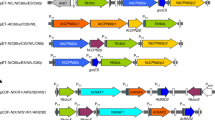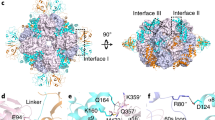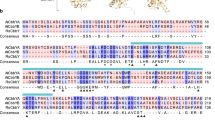Abstract
Ribulose-1,5-bisphosphate carboxylase/oxygenase (Rubisco) catalyses the conversion of atmospheric CO2 into organic compounds during photosynthesis. Despite its pivotal role in plant metabolism, Rubisco is an inefficient enzyme and has therefore been a key target in bioengineering efforts to improve crop yields. Much has been learnt about the complex cellular machinery involved in Rubisco assembly and metabolic repair over recent years. The simple form of Rubisco found in certain bacteria and dinoflagellates comprises two large subunits, and generally requires the chaperonin system for folding. However, the evolution of hexadecameric Rubisco, which comprises eight large and eight small subunits, from its dimeric precursor has rendered Rubisco in most plants, algae, cyanobacteria and proteobacteria dependent on an array of additional factors. These auxiliary factors include several chaperones for assembly as well as ATPases of the AAA+ family for functional maintenance. An integrated view of the pathways underlying Rubisco biogenesis and repair will pave the way for efforts to improve the enzyme with the goal of increasing crop yields.
This is a preview of subscription content, access via your institution
Access options
Subscribe to this journal
Receive 12 digital issues and online access to articles
$119.00 per year
only $9.92 per issue
Buy this article
- Purchase on Springer Link
- Instant access to full article PDF
Prices may be subject to local taxes which are calculated during checkout






Similar content being viewed by others
References
Andersson, I. & Backlund, A. Structure and function of Rubisco. Plant Physiol. Biochem. 46, 275–291 (2008).
Field, C. B., Behrenfeld, M. J., Randerson, J. T. & Falkowski, P. Primary production of the biosphere: integrating terrestrial and oceanic components. Science 281, 237–240 (1998).
Miziorko, H. M. & Lorimer, G. H. Ribulose-1,5-bisphosphate carboxylase-oxygenase. Annu. Rev. Biochem. 52, 507–535 (1983).
Hartman, F. C. & Harpel, M. R. Structure, function, regulation, and assembly of D-Ribulose-1,5-bisphosphate carboxylase/oxygenase. Annu. Rev. Biochem. 63, 197–234 (1994).
Ellis, R. J. Biochemistry: Tackling unintelligent design. Nature 463, 164–165 (2010).
Andersson, I. Catalysis and regulation in Rubisco. J. Exp. Bot. 59, 1555–1568 (2008).
Portis, A. R. & Parry, M. A. J. Discoveries in Rubisco (Ribulose 1,5-bisphosphate carboxylase/oxygenase): a historical perspective. Photosynth. Res. 94, 121–143 (2007).
Maurino, V. G. & Peterhansel, C. Photorespiration: current status and approaches for metabolic engineering. Curr. Opin. Plant Biol. 13, 249–256 (2010).
Peterhansel, C., Niessen, M. & Kebeish, R. M. Metabolic engineering towards the enhancement of photosynthesis. Photochem. Photobiol. 84, 1317–1323 (2008).
Whitney, S. M., Houtz, R. L. & Alonso, H. Advancing our understanding and capacity to engineer nature's CO2-sequestering enzyme, Rubisco. Plant Physiol. 155, 27–35 (2011).
Pearce, F. G. Catalytic by-product formation and ligand binding by Ribulose bisphosphate carboxylases from different phylogenies. Biochem. J. 399, 525–534 (2006).
Evans, J. R. & von Caemmerer, S. Enhancing photosynthesis. Plant Physiol. 155, 19 (2011).
Raines, C. A. Increasing photosynthetic carbon assimilation in C3 plants to improve crop yield: current and future strategies. Plant Physiol. 155, 36–42 (2011).
Evans, J. R. Improving photosynthesis. Plant Physiol. 162, 1780–1793 (2013).
Parry, M. A. J. et al. Rubisco activity and regulation as targets for crop improvement. J. Exp. Bot. 64, 717–730 (2013).
Tabita, F. R., Satagopan, S., Hanson, T. E., Kreel, N. E. & Scott, S. S. Distinct form I, II, III, and IV Rubisco proteins from the three kingdoms of life provide clues about Rubisco evolution and structure/function relationships. J. Exp. Bot. 59, 1515–1524 (2008).
Parry, M. A., Andralojc, P. J., Mitchell, R. A., Madgwick, P. J. & Keys, A. J. Manipulation of Rubisco: the amount, activity, function and regulation. J. Exp. Bot 54, 1321–1333 (2003).
Spreitzer, R. J. Role of the small subunit in Ribulose-1,5-bisphosphate carboxylase/oxygenase. Arch. Biochem. Biophys. 414, 141–149 (2003).
Ishikawa, C., Hatanaka, T., Misoo, S., Miyake, C. & Fukayama, H. Functional incorporation of sorghum small subunit increases the catalytic turnover rate of Rubisco in transgenic rice. Plant Physiol. 156, 1603–1611 (2011).
Tabita, F. R. Microbial Ribulose 1,5-bisphosphate carboxylase/oxygenase: a different perspective. Photosynth. Res. 60, 1–28 (1999).
Schwenkert, S., Soll, J. & Bolter, B. Protein import into chloroplasts—how chaperones feature into the game. Biochim. Biophys. Acta 1808, 901–911 (2011).
Whitney, S. M., Baldet, P., Hudson, G. S. & Andrews, T. J. Form I Rubiscos from non-green algae are expressed abundantly but not assembled in tobacco chloroplasts. Plant J. 26, 535–547 (2001).
Duff, A. P., Andrews, T. J. & Curmi, P. M. The transition between the open and closed states of rubisco is triggered by the inter-phosphate distance of the bound bisphosphate. J. Mol. Biol. 298, 903–916 (2000).
Barraclough, R. & Ellis, R. J. Protein synthesis in chloroplasts. IX. Assembly of newly-synthesized large subunits into Ribulose bisphosphate carboxylase in isolated intact pea chloroplasts. Biochim. Biophys. Acta 608, 18–31 (1980).
Hartl, F. U. & Hayer-Hartl, M. The first chaperonin. Nature Rev. Mol. Cell Biol. 14, 611 (2013).
Kim, Y. E., Hipp, M. S., Bracher, A., Hayer-Hartl, M. & Hartl, F. U. Molecular chaperone functions in protein folding and proteostasis. Annu. Rev. Biochem. 82, 323–355 (2013).
Brinker, A. et al. Dual function of protein confinement in chaperonin-assisted protein folding. Cell 107, 223–233 (2001).
Liu, C. et al. Coupled chaperone action in folding and assembly of hexadecameric Rubisco. Nature 463, 197–202 (2010).
Vitlin Gruber, A., Nisemblat, S., Azem, A. & Weiss, C. The complexity of chloroplast chaperonins. Trends Plant Sci. 18, 688–694 (2013).
Weiss, C., Bonshtien, A., Farchi-Pisanty, O., Vitlin, A. & Azem, A. Cpn20: siamese twins of the chaperonin world. Plant Mol. Biol. 69, 227–238 (2009).
Tsai, Y-C. C., Mueller-Cajar, O., Saschenbrecker, S., Hartl, F. U. & Hayer-Hartl, M. Chaperonin cofactors, Cpn10 and Cpn20, of green algae and plants function as hetero-oligomeric ring complexes. J. Biol. Chem. 287, 20471–20481 (2012).
Vitlin Gruber, A., Zizelski, G., Azem, A. & Weiss, C. The Cpn10(1) co-chaperonin of A. thaliana functions only as a hetero-oligomer with Cpn20. PLoS ONE 9, e113835 (2014).
Saibil, H. R., Fenton, W. A., Clare, D. K. & Horwich, A. L. Structure and allostery of the chaperonin GroEL. J. Mol. Biol. 425, 1476–1487 (2013).
Bonshtien, A. L. et al. Differential effects of co-chaperonin homologs on Cpn60 oligomers. Cell Stress Chaperones 14, 509–519 (2009).
Kerner, M. J. et al. Proteome-wide analysis of chaperonin-dependent protein folding in Escherichia coli. Cell 122, 209–220 (2005).
Goloubinoff, P., Christeller, J. T., Gatenby, A. A. & Lorimer, G. H. Reconstitution of active dimeric Ribulose bisphosphate carboxylase from an unfolded state depends on two chaperonin proteins and MgATP. Nature 342, 884–889 (1989).
Georgescauld, F. et al. GroEL/ES chaperonin modulates the mechanism and accelerates the rate of TIM-barrel domain folding. Cell 157, 922–934 (2014).
Larimer, F. W. & Soper, T. S. Overproduction of Anabaena 7120 Ribulose-bisphosphate carboxylase/oxygenase in Escherichia coli. Gene 126, 85–92 (1993).
Emlyn-Jones, D., Woodger, F. J., Price, G. D. & Whitney, S. M. RbcX can function as a Rubisco chaperonin, but is non-essential in Synechococcus PCC7942. Plant Cell Physiol. 47, 1630–1640 (2006).
Andrews, T. J. Catalysis by cyanobacterial Ribulose-bisphosphate carboxylase large subunits in the complete absence of small subunits. J. Biol. Chem. 263, 12213–12219 (1988).
Saschenbrecker, S. et al. Structure and function of RbcX, an assembly chaperone for hexadecameric Rubisco. Cell 129, 1189–1200 (2007).
Kolesinski, P., Belusiak, I., Czarnocki-Cieciura, M. & Szczepaniak, A. Rubisco accumulation factor 1 from Thermosynechococcus elongatus participates in the final stages of Ribulose-1,5-bisphosphate carboxylase/oxygenase assembly in Escherichia coli cells and in vitro. FEBS J. 281, 3920–3932 (2014).
Tabita, F. R. Rubisco: The enzyme that keeps on giving. Cell 129, 1039–1040 (2007).
Li, L-A. & Tabita, F. R. Maximum activity of recombinant Ribulose 1,5-bisphosphate carboxylase/oxygenase of Anabaena sp. strain CA requires the product of the rbcx gene. J. Bact. 179, 3793–3796 (1997).
Onizuka, T. et al. The rbcX gene product promotes the production and assembly of Ribulose-1, 5-bisphosphate carboxylase/oxygenase of Synechococcus sp. PCC7002 in Escherichia coli. Plant Cell Physiol. 45, 1390–1395 (2004).
Tanaka, S., Sawaya, M. R., Kerfeld, C. A. & Yeates, T. O. Structure of the Rubisco chaperone RbcX from Synechocystis sp. PCC6803. Acta Crystallogr. D Biol. Crystallogr. 63, 1109–1112 (2007).
Tarnawski, M., Krzywda, S., Bialek, W., Jaskolski, M. & Szczepaniak, A. Structure of the Rubisco chaperone RbcX from the thermophilic cyanobacterium Thermosynechococcus elongatus. Acta Crystallogr. F Struct. Biol. Cryst. Commun. 67, 851–857 (2011).
Kolesinski, P. et al. Insights into eukaryotic Rubisco assembly — Crystal structures of RbcX chaperones from Arabidopsis thaliana. Biochim. Biophys. 1830, 2899–2906 (2013).
Kolesinski, P., Piechota, J. & Szczepaniak, A. Initial characteristics of RbcX proteins from Arabidopsis thaliana. Plant Mol. Biol. 77, 447–459 (2011).
Bracher, A., Starling-Windhof, A., Hartl, F. U. & Hayer-Hartl, M. Crystal structure of a chaperone-bound assembly intermediate of form I Rubisco. Nature Struct. Mol. Biol. 18, 875–880 (2011).
van Lun, M., van der Spoel, D. & Andersson, I. Subunit interface dynamics in hexadecameric Rubisco. J. Mol. Biol. 411, 1083–1098 (2011).
Tarnawski, M., Gubernator, B., Kolesinski, P. & Szczepaniak, A. Heterologous expression and initial characterization of recombinant RbcX protein from Thermosynechococcus elongatus BP-1 and the role of RbcX in Rubisco assembly. Acta Biochim. Pol. 55, 777–785 (2008).
Pechmann, S., Willmund, F. & Frydman, J. The ribosome as a hub for protein quality control. Mol. Cell 49, 411–421 (2013).
Checa, S. K. & Viale, A. M. The 70-Kda Heat-shock protein Dnak chaperone system is required for the productive folding of Ribulose-bisphosphate carboxylase subunits in Escherichia Coli. Eur. J. Biochem. 248, 848–855 (1997).
Ivey, R. A. III, Subramanian, C. & Bruce, B. D. Identification of a Hsp70 recognition domain within the rubisco small subunit transit peptide. Plant Physiol. 122, 1289–1299 (2000).
Friso, G., Majeran, W., Huang, M., Sun, Q. & van Wijk, K. J. Reconstruction of metabolic pathways, protein expression, and homeostasis machineries across maize bundle sheath and mesophyll chloroplasts: large-scale quantitative proteomics using the first maize genome assembly. Plant Physiol. 152, 1219–1250 (2010).
Brutnell, T. P., Sawers, R. J., Mant, A. & Langdale, J. A. Bundle sheath defective2, a novel protein required for post-translational regulation of the rbcL gene of maize. Plant Cell 11, 849–864 (1999).
Doron, L., Segal, N., Gibori, H. & Shapira, M. The Bsd2 ortholog in Chlamydomonas reinhardtii is a polysome-associated chaperone that co-migrates on sucrose gradients with the rbcL transcript encoding the Rubisco large subunit. Plant J. 80, 345–355 (2014).
Kampinga, H. H. & Craig, E. A. The Hsp70 chaperone machinery: J proteins as drivers of functional specificity. Nature Rev. Mol. Cell Biol. 11, 579–592 (2010).
Feiz, L. et al. Ribulose-1, 5-bis-phosphate carboxylase/oxygenase accumulation factor1 is required for holoenzyme assembly in maize. Plant Cell 24, 3435–3446 (2012).
Wheatley, N. M., Sundberg, C. D., Gidaniyan, S. D., Cascio, D. & Yeates, T. O. Structure and identification of a pterin dehydratase-like protein as a Ribulose-bisphosphate carboxylase/oxygenase (Rubisco) assembly factor in the alpha-carboxysome. J. Biol. Chem. 289, 7973–7981 (2014).
Feiz, L. et al. A protein with an inactive pterin-4a-carbinolamine dehydratase domain is required for Rubisco biogenesis in plants. Plant J. 80, 862–869 (2014).
Whitney, S. M., Birch, R., Kelso, C., Beck, J. L. & Kapralov, M. V. Improving recombinant Rubisco biogenesis, plant photosynthesis and growth by co-expressing its ancillary RAF1 chaperone. Proc. Natl. Acad. Sci. USA http://doi.org/4rj (2015).
Joshi, J., Mueller-Cajar, O., Tsai, Y. C., Hartl, F. U. & Hayer-Hartl, M. Role of small subunit in mediating assembly of red-type form 1 Rubisco. J. Biol. Chem. 290, 1066–1074 (2015).
Feller, U., Anders, I. & Mae, T. Rubiscolytics: fate of Rubisco after its enzymatic function in a cell is terminated. J. Exp. Bot. 59, 1615–1624 (2008).
Portis, A. R., Li, C. S., Wang, D. F. & Salvucci, M. E. Regulation of Rubisco activase and its interaction with Rubisco. J. Exp. Bot. 59, 1597–1604 (2008).
Mueller-Cajar, O., Stotz, M. & Bracher, A. Maintaining photosynthetic CO2 fixation via protein remodelling: the Rubisco activases. Photosynth. Res. 119, 191–201 (2014).
Parry, M. A. J., Keys, A. J., Madgwick, P. J., Carmo-Silva, A. E. & Andralojc, P. J. Rubisco regulation: a role for inhibitors. J. Exp. Bot. 59, 1569–1580 (2008).
Hanson, P. I. & Whiteheart, S. W. AAA+ proteins: Have engine, will work. Nature Rev. Mol. Cell Biol. 6, 519–529 (2005).
Snider, J., Thibault, G. & Houry, W. A. The AAA+ superfamily of functionally diverse proteins. Genome Biol. 9, 216 (2008).
Wendler, P., Ciniawsky, S., Kock, M. & Kube, S. Structure and function of the AAA+ nucleotide binding pocket. Biochim. Biophys. Acta 1823, 2–14 (2012).
Mueller-Cajar, O. et al. Structure and function of the AAA+ protein CbbX, a red-type Rubisco activase. Nature 479, 194–199 (2011).
Stotz, M. et al. Structure of green-type Rubisco activase from tobacco. Nature Struct. Mol. Biol. 18, 1366–1370 (2011).
Henderson, J. N., Kuriata, A. M., Fromme, R., Salvucci, M. E. & Wachter, R. M. Atomic resolution X-ray structure of the substrate recognition domain of higher plant Ribulose-bisphosphate carboxylase/oxygenase (Rubisco) activase. J. Biol. Chem. 286, 35683–35688 (2011).
Bracher, A., Sharma, A., Starling-Windhof, A., Hartl, F. U. & Hayer-Hartl, M. Degradation of potent Rubisco inhibitor by selective sugar phosphatase. Nature Plants 1, 14002 (2015).
Linster, C. L., Van Schaftingen, E. & Hanson, A. D. Metabolite damage and its repair or pre-emption. Nature Chem. Biol. 9, 72–80 (2013).
Blayney, M. J., Whitney, S. M. & Beck, J. L. NanoESI mass spectrometry of Rubisco and Rubisco activase structures and their interactions with nucleotides and sugar phosphates. J. Am. Soc. Mass Spectrom. 22, 1588–1601 (2011).
Chakraborty, M. et al. Protein oligomerization monitored by fluorescence fluctuation spectroscopy: self-assembly of rubisco activase. Biophys. J. 103, 949–958 (2012).
Keown, J. R., Griffin, M. D. W., Mertens, H. D. T. & Pearce, F. G. Small oligomers of Ribulose-bisphosphate carboxylase/oxygenase (Rubisco) activase are required for biological activity. J. Biol. Chem. 288, 20607–20615 (2013).
Henderson, J. N., Hazra, S., Dunkle, A. M., Salvucci, M. E. & Wachter, R. M. Biophysical characterization of higher plant Rubisco activase. Biochim. Biophys. Acta 1834, 87–97 (2013).
Kuriata, A. M. et al. ATP and magnesium promote cotton short-form Ribulose-1,5-bisphosphate carboxylase/oxygenase (Rubisco) activase hexamer formation at low micromolar concentrations. Biochemistry 53, 7232–7246 (2014).
Keown, J. R. & Pearce, F. G. Characterization of spinach Ribulose-1,5-bisphosphate carboxylase/oxygenase activase isoforms reveals hexameric assemblies with increased thermal stability. Biochem. J. 464, 413–423 (2014).
Wachter, R. M. et al. Activation of interspecies-hybrid Rubisco enzymes to assess different models for the Rubisco-Rubisco activase interaction. Photosynth. Res. 117, 557–566 (2013).
Sage, R. F., Way, D. A. & Kubien, D. S. Rubisco, Rubisco activase, and global climate change. J. Exp. Bot. 59, 1581–1595 (2008).
Nisbet, E. G. et al. The age of Rubisco: the evolution of oxygenic photosynthesis. Geobiology 5, 311–335 (2007).
Mueller-Cajar, O. & Whitney, S. M. Directing the evolution of Rubisco and Rubisco activase: first impressions of a new tool for photosynthesis research. Photosynth. Res. 98, 667–675 (2008).
Maisnier-Patin, S. et al. Genomic buffering mitigates the effects of deleterious mutations in bacteria. Nature Genet. 37, 1376–1379 (2005).
Tokuriki, N. & Tawfik, D. S. Stability effects of mutations and protein evolvability. Curr. Opin. Struct. Biol. 19, 596–604 (2009).
Williams, T. A. & Fares, M. A. The effect of chaperonin buffering on protein evolution. Genome Biol. Evol. 2, 609–619 (2010).
Bogumil, D. & Dagan, T. Cumulative impact of chaperone-mediated folding on genome evolution. Biochemistry 51, 9941–9953 (2012).
Wyganowski, K. T., Kaltenbach, M. & Tokuriki, N. GroEL/ES buffering and compensatory mutations promote protein evolution by stabilizing folding intermediates. J. Mol. Biol. 425, 3403–3414 (2013).
Tokuriki, N. & Tawfik, D. S. Chaperonin overexpression promotes genetic variation and enzyme evolution. Nature 459, 668–671 (2009).
Bershtein, S., Mu, W., Serohijos, A. W. R., Zhou, J. & Shakhnovich, E. I. Protein quality control acts on folding intermediates to shape the effects of mutations on organismal fitness. Mol. Cell 49, 133–144 (2013).
Greene, D. N., Whitney, S. M. & Matsumura, I. Artificially evolved Synechococcus PCC6301 Rubisco variants exhibit improvements in folding and catalytic efficiency. Biochem. J. 404, 517–524 (2007).
Mueller-Cajar, O. & Whitney, S. M. Evolving improved Synechococcus Rubisco functional expression in Escherichia coli. Biochem. J. 414, 205–214 (2008).
Durão, P. et al. Opposing effects of folding and assembly chaperones on evolvability of Rubisco. Nature Chem. Biol. 11, 148–155 (2015).
Zarzycki, J., Axen, S. D., Kinney, J. N. & Kerfeld, C. A. Cyanobacterial-based approaches to improving photosynthesis in plants. J. Exp. Bot. 64, 787–798 (2013).
Lin, M. T., Occhialini, A., Andralojc, P. J., Parry, M. A. & Hanson, M. R. A faster Rubisco with potential to increase photosynthesis in crops. Nature 513, 547–550 (2014).
Notredame, C., Higgins, D. G. & Heringa, J. T-Coffee: A novel method for fast and accurate multiple sequence alignment. J. Mol. Biol. 302, 205–217 (2000).
Huson, D. H. & Scornavacca, C. Dendroscope 3: an interactive tool for rooted phylogenetic trees and networks. Systematic Biol. 61, 1061–1067 (2012).
Author information
Authors and Affiliations
Corresponding author
Ethics declarations
Competing interests
The authors declare no competing financial interests.
Supplementary information
Rights and permissions
About this article
Cite this article
Hauser, T., Popilka, L., Hartl, F. et al. Role of auxiliary proteins in Rubisco biogenesis and function. Nature Plants 1, 15065 (2015). https://doi.org/10.1038/nplants.2015.65
Received:
Accepted:
Published:
DOI: https://doi.org/10.1038/nplants.2015.65
This article is cited by
-
Tracking nitrogen allocation to proteome biosynthesis in a marine microbial community
Nature Microbiology (2023)
-
An ancient metabolite damage-repair system sustains photosynthesis in plants
Nature Communications (2023)
-
Phytotoxic Responses and Plant Tolerance Mechanisms to Cadmium Toxicity
Journal of Soil Science and Plant Nutrition (2023)
-
Towards engineering a hybrid carboxysome
Photosynthesis Research (2023)
-
Engineering Cupriavidus necator H16 for enhanced lithoautotrophic poly(3-hydroxybutyrate) production from CO2
Microbial Cell Factories (2022)



